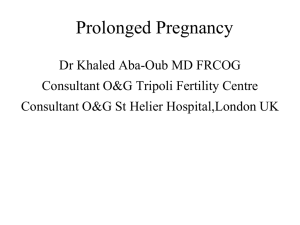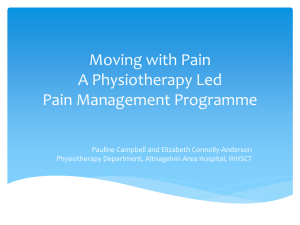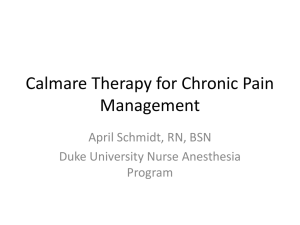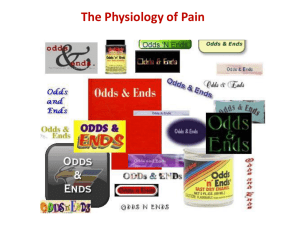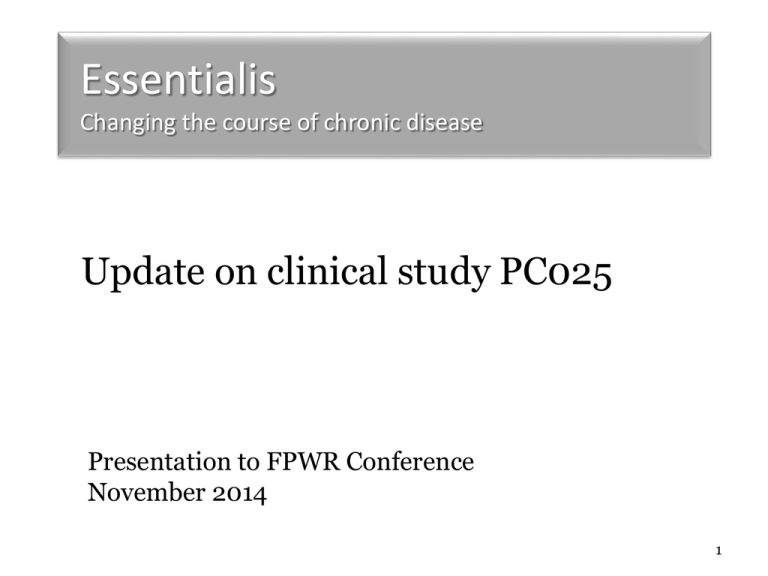
Essentialis
Changing the course of chronic disease
Update on clinical study PC025
Presentation to FPWR Conference
November 2014
1
Agenda
Introduction
MOA in Prader-Willi syndrome
PC025 Interim Results
Essentialis
Changing the course of chronic disease
2
Introduction to Essentialis
• Carlsbad, CA based, clinical stage, venture
backed drug development company
• Focused on development of activators or openers
of the ATP-sensitive potassium (KATP) channel to
treat orphan diseases
Essentialis
Changing the course of chronic disease
3
Products – Based on Patented Active
• Diazoxide choline is a patent protected,
proprietary salt of diazoxide
• Formulated as
– Once per day tablet – DCCR
• Tested in more than 200 subjects to date
– Oral solution – DCOS
– IV solution - DCIV
Essentialis
Changing the course of chronic disease
4
Diazoxide – Long History of Safe Use
Diazoxide
• KATP channel agonist
• IV treatment for malignant hypertension
– First Approved 1973 and used through the 80’s,
no longer available
• Oral suspension for the treatment of insulinoma in adults
and CHI in neonates and children
– Approved 1976 and remains standard of care globally
• More than 110,000 patient-years of chronic use
Essentialis
Changing the course of chronic disease
5
Agenda
Introduction
MOA in Prader-Willi syndrome
PC025 Interim Results
Essentialis
Changing the course of chronic disease
6
Hyperphagia in PWS is most likely due to
dysregulation of neurons in the hypothalamus
Dysregulation of
AgRP and POMC
neurons will result
in increased food
intake and reduced
energy expenditure
DCCR may reduce
this dysregulation
Appetite
Reduced food
intake
Essentialis
Changing the course of chronic disease
7
DCCR has peripheral impacts that complement
the central effect
Synthesis of fat
Long Chain
fatty acids
Use of fat as fuel
DCCR coordinately
down-regulates denovo synthesis of fatty
acids by down
regulating ACCase and
FAS and upregulates
β-oxidation of fat
reducing fat stores
Triglycerides
Energy
production
Acetyl-CoA
Fatty acids
Triglycerides
Fat Stores
Essentialis
Changing the course of chronic disease
8
DCCR may affect key neurotransmitters
• Gamma-amino butyric acid (GABA) is an important
neurotransmitter
• In PWS
– The expression of GABA-A receptors is
diminished
– GABA concentrations are markedly elevated
– Likely leads to receptor desensitization
– May be associated with aggressive behaviors
• DCCR reduces GABA concentrations, may restore
sensitivity, potentially reducing aggressive behaviors
Essentialis
Changing the course of chronic disease
9
DCCR - Mode of Action in PWS
• DCCR
– In the hypothalamus
• Reduces dysregulation of key neurons - reducing the
central starvation signal
– Peripherally
• Coordinately down-regulates synthesis of fats and
upregulates the use of fat as fuel - reducing fat stores
– Centrally
• May restore sensitivity to GABA
• Overall
– Reduces hyperphagia, increases energy
expenditure, reduces fat mass and weight, may
impact aggressive behaviors
Essentialis
Changing the course of chronic disease
10
Agenda
Introduction
MOA in Prader-Willi syndrome
PC025 Interim Results
Essentialis
Changing the course of chronic disease
11
PC025 Pilot Study
Open label titration followed by randomized withdrawal
Pilot Study of DCCR in obese,
genetically confirmed PWS patients
between 10 and 22 years
• Being conducted at the University
of California, Irvine
• Up to12 patients
• Total duration of treatment 14
weeks
• Open label dose escalation 1.5
mg/kg to 5 mg/kg (titrated in 4
steps every 2 weeks) – 10
weeks
• Last 4 weeks are a double-blind,
placebo-controlled, randomized
withdrawal extension
– Randomized 1:1 to continue on
dose or receive placebo
– 4 additional weeks of treatment
• Endpoints: hyperphagia, REE;
exploratory – weight, BMI, fat
mass, lean body mass, RQ,
behaviors, endocrine and glycemic
parameters
Recruitment 4 more patients
Essentialis
Changing the course of chronic disease
12
Schematic of study
Screening
(up to
4 wks)
Double-Blind,
PlaceboControlled,
Randomized
Withdrawal
Extension
(4 wks)
Open Label Treatment Period
(10 wks)
Base
4 wks
line
2 wks
2 wks
2 wks
2 wks
2 wks
4 wks
5.1
mg/kg
Day 55 dose or
Placebo
Equivalent for
Responders and
Day 0
1.5
mg/kg
2.4
mg/kg
3.3
mg/kg
4.2
mg/kg
5.1
mg/kg
Day 55 dose for
Non-Responders
Essentialis
Changing the course of chronic disease
13
Efficacy endpoints in PC025
Parameter
Measured by
Measured at
Hyperphagia
Questionnaire
Every visit
Body fat
DEXA
Screening or Baseline, 10 wks
Lean body mass
DEXA
Behaviors
Questionnaire
Screening and 10 wks
Weight
Scale
Every visit
Resting energy
expenditure
Indirect
calorimetry
Baseline, 4 wks, 8 wks, 10 wks, 14 wks
Respiratory
quotient
Indirect
calorimetry
Baseline, 4 wks, 8 wks, 10 wks, 14 wks
Blood pressure
Automated
Every visit
Lipids
Lab assay
Baseline, 10 wks
Essentialis
Changing the course of chronic disease
Screening or Baseline, 10 wks
14
Patients enrolled in the study to date
Parameter
Baseline average (range)
Sex
4 F/6 M
Age
16 yr (11 - 21 yr)
PWS sub-type
All deletions
GH treatment
3 Y/7 N
Weight
92.3 kg (56.9 - 133.6 kg)
Percent body fat
53.4 % (42.9 – 60.7%)
BMI
40.1 (25 – 53.8)
Hyperphagia score (0 – 34)
16.4 (3 – 25.5)
Essentialis
Changing the course of chronic disease
15
PC025 – Hyperphagia: High response rate
statistically significant improvements
• Hyperphagia response rate to DCCR is high ~ 87.5%
– Statistically significant improvements in hyperphagia (~33%
reduction)
– Response is better or more durable in those who responded
with baseline hyperphagia scores below 20
Baseline
hyperphagia
< 20
≥ 20
N
4
3
Improvement
in hyperphagia
39.7%
24.0%
– Initial hyperphagia response observed at the two lowest doses
Essentialis
Changing the course of chronic disease
16
Results are confirmed by verbatim statements
from parents
• “She never misses her breakfast, lunch,
snack, or dinner. Usually she asks for
more food. But surprisingly she said she
feels full. This has never happened before.
She skipped her lunch!”
• “It seems like my child is less interested in
food”
• “He is no longer getting up at night for
food and digging through the trash!”
Essentialis
Changing the course of chronic disease
17
Other efficacy responses
Efficacy Parameter
Response
Yelling/ aggressive / destructive/
threatening behavior
Stopped
Weight
- 1.0 kg
Body fat
- 2.4%
Lean body mass
+3.33% in GH patients
with no change in nonGH
Resting energy expenditure
+ 90 kcal/day
Fuel source
Shift towards burning
more fat as fuel
Blood pressure and lipids
Improvements are
known effect of drug
Essentialis
Changing the course of chronic disease
18
PC025 – Interim results
• Response occurring at very low doses of
DCCR
– Below the labeled range of diazoxide in its
approved indication
• Drug appears to be well tolerated
Essentialis
Changing the course of chronic disease
19
Safety
• The most common adverse events
– Peripheral edema
• Often transient
• Associated with the blood pressure lowering effect
• Mechanism similar to that of other blood pressure
lowering drugs
– Potential to raise glucose levels
• A small subset of patients are particularly sensitive
and can be quickly identified
Essentialis
Changing the course of chronic disease
20
DCCR in PWS Next Steps
• Complete pilot study
• Our thinking on the development plan is
evolving as interim data becomes available
• Open a dialogue on development with FDA
• Raise the funds to continue development
Essentialis
Changing the course of chronic disease
21



